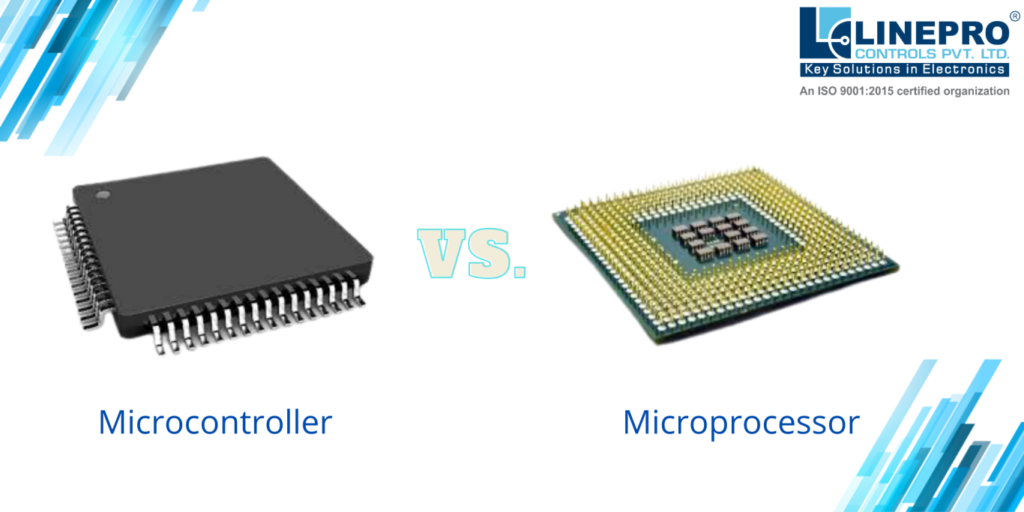
The difference between a microprocessor and a microcontroller is mainly related to their functionality difference. Based on reliable experience, engineers can differentiate them. But for a newbie, it becomes a daunting task to differentiate, as both microcontroller and microprocessor appear to be the same.
Microprocessor and microcontroller are examples of single-chip processors that have aided in the growth of computing technology by increasing reliability and reducing the price in processing. Surprisingly, it appears that microprocessors and microcontrollers share something in common. Both are single-chip integrated circuits that implement computation logic. Both types of processors are present in various electronic devices across the globe.
This article will explore every difference between a microcontroller and a microprocessor from architecture to applications, allowing us to gain a thorough knowledge of which of these components will power your next project. To find in-depth the fundamental differences between microcontroller and microprocessor, we have put this article that compares them.
First, let us understand what Microcontroller and Microprocessor is:
What is a Microcontroller?
The microcontroller (MCU) is an individual Integrated Circuit (IC) that is generally used to support an application specific to it and developed to accomplish specific tasks. Equipment and gadgets that have to be controlled automatically in specific situations, such as appliances and power tools, and automotive engine control systems, are excellent examples. Still, microcontrollers go far beyond the applications mentioned above.
The basic idea is that a microcontroller takes information from the user, processes it, and then outputs an action based on its gathered data. Microcontrollers generally work at a much slower speed, in 1MHz-200 MHz.
What is Microprocessor?
A computer’s Central Processing Unit (CPU) constructed on a single Integrated Circuit (IC) is a microprocessor.
A computer with one microprocessor, which functions as a CPU, is a microcomputer. It is a programmable multi-purpose, clock-driven, register-based electronic device which reads binaries from a storage device, also known as memory, which accepts binary data as input, and then processes it under the instructions and produces output. The microprocessor has millions of tiny components such as registers, transistors, and diodes.
A microprocessor comprises an Arithmetic Logic Unit (ALU), a control unit, and a register array. The register array is where the ALU executes logical and arithmetic operations on data obtained through an input device or in memory. Input devices designed by Linepro Controls like Membrane Keypad and Metal Keyboards facilitate communication with the microcontroller. The control unit manages the instructions and data flow inside the computer. The register array consists of registers identified with alphabets like B, C, D, H, E, and the accumulator.
Difference between Microcontroller and Microprocessor
Now that we know what microcontrollers and microprocessors are let us fundamentally understand the differences between the two. It is essential to know the difference as it impacts the project outcomes and design considerations for the computer engineering and embedded projects we are involved in. So, let us get started in knowing the differences between microcontrollers and microprocessors.
Microcontroller and Microprocessor Speed Comparison
In terms of the overall speed, there’s a noticeable difference between top-of-the-line microprocessors and microcontrollers. This directly results from the notion that microcontrollers are designed to perform a specific project or job. In contrast, microprocessors handle more complicated, robust, and difficult computer tasks.
One of the significant advantages of microcontrollers is that they are customizable to run optimized code to accomplish a particular job. This means that they use the appropriate amount of power and speed to complete the task, not more or less. This is why numerous microprocessors clock speeds as high as 4GHz, while microcontrollers can operate at lower rates of 200 MHz or less.
In the same way, the proximity of on-chip components can enable microcontrollers to achieve their tasks faster, even with a slower clock speed. Microprocessors sometimes operate slower due to their dependence on communication with external peripherals.
Microcontroller and Microprocessor Power Consumption Comparison
One of the significant benefits of microcontrollers is their energy consumption. A computer processor used for a specialized task needs lower speed, which means less power than a processor with a high computational capability. Power consumption plays a significant part in the design. A processor that draws lots of power might require to be connected or powered by an external power source in contrast to a processor which uses a small amount of power can be powered for an extended duration by a tiny battery.
For jobs that require little processing power, it may be more economical to use a microcontroller instead of the microprocessor, which consumes more power to achieve similar output.
Costing Comparison
In general, the cost of microcontrollers is generally lower than microprocessors. Microprocessors are usually designed with higher-end devices that rely on external peripherals to boost performance. They are also more complicated since they are designed to carry out various computation tasks, while microcontrollers generally have a specific function. This is another reason microprocessors need a reliable external memory source to handle more complicated computation tasks.
With microcontrollers, the engineers compose and write a program for the specific application and then upload it to the microcontroller’s internal circuitry, which houses all the essential computing capabilities and components needed to run the program. Because of their specialized applications, microcontrollers typically require less memory and less computing power and have less complexity overall than microprocessors, which is why they are less expensive.
Architecture Comparison
Microcontrollers and microprocessors serve similar tasks. However, when we examine the structure of each kind of chip, we’ll be able to see how distinct they are.
The most distinctive feature of the microcontroller is that it integrates all the required computing components on a single chip. The CPU memory, interrupt controls and timer, bus control, serial ports, I/O peripheral ports, and other essential components are all contained in the same device. There is no need for external circuits.
However, the microprocessor consists of a processor and several other chips that provide the memory serial interface, inputs and outputs, timers, and other essential components. Numerous sources indicate that “microprocessor” or “CPU” is identical. However, you might see microprocessor architecture diagrams that show the CPU as an element within the microprocessor. One can consider a microprocessor an integrated circuit chip that houses the CPU. It can be connected to external peripherals, like a data bus or control bus, which can offer binary data inputs and take outputs directly from the microprocessor (also as binary).
The main difference is that microcontrollers are entirely self-contained. All the required computing peripherals are built into the chip, whereas microprocessors can interface directly with peripherals from outside.
Application Comparison
Microcontrollers and microprocessors are both ways to implement CPUs into computing. We know microcontrollers incorporate the CPU into the chip and other peripherals, and a microprocessor comprises the CPU, which has wired connections to other support chips. While there could be some similarities, microprocessors and microcontrollers are distinct and have unique functions.
Microprocessors rely on interfacing with several other chips to create an integrated microcomputer. They are typically employed in personal computers, where users require fast, powerful processors to provide a wide range of computing functions. External peripherals equipped with microprocessors ensure that components are easily upgraded; for instance, users could replace their RAM chip to gain more memory.
Programmable microcontrollers house all the microcomputer’s components system in a single chip, which runs on low power and can perform an exclusively dedicated operation. Microcontrollers are typically used in embedded systems in which devices are expected to perform basic tasks with a high degree of accuracy and without interference from humans for prolonged durations of time.
Conclusion
Microcontrollers are designed to run the functions of a specific low-power application, ideal for embedded systems. At the same time, microprocessors are better for general computing tasks that require more intricate and flexible computing. A microcontroller places the CPU and other peripherals on one processor; the microprocessor has the most powerful CPU in a single chip connected to external peripherals. Microprocessors and microcontrollers are two different methods to organize and optimize an electronic system that is CPU-based.

